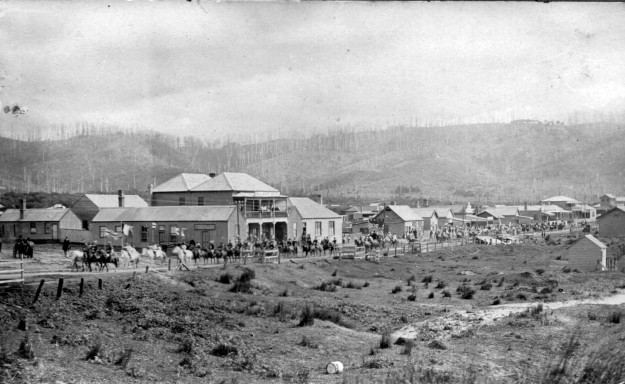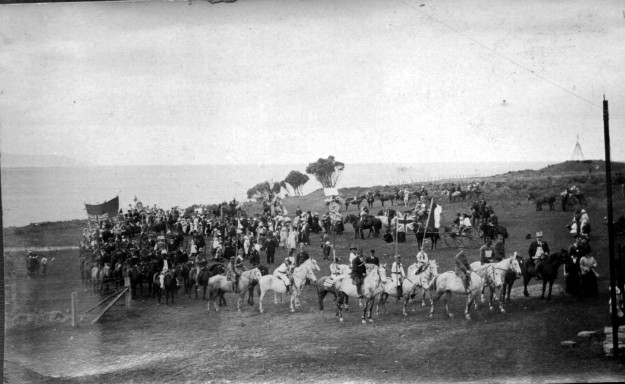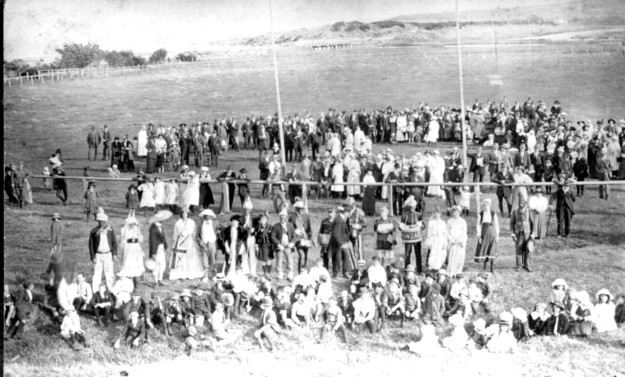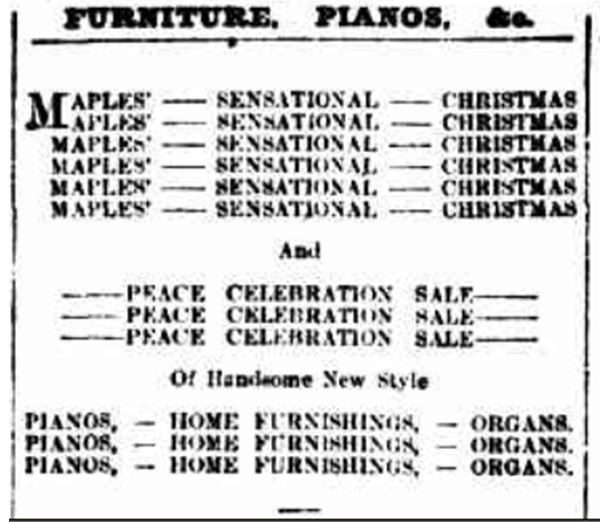 You lived in the small town of Apollo Bay on the south coast of Victoria. So what did you do when the need to celebrate arose.. The usual thing was to hold a procession, follow it with a lunch, then some sports at the oval in the afternoon and conclude with a concert at night.
You lived in the small town of Apollo Bay on the south coast of Victoria. So what did you do when the need to celebrate arose.. The usual thing was to hold a procession, follow it with a lunch, then some sports at the oval in the afternoon and conclude with a concert at night.
This is how Apollo Bay decided to celebrate Peace in July 1919. On June 28, 1919, Germany and the Allied Nations (including Britain, France, Italy and Russia) had signed the Treaty of Versailles, formally ending the war. The procession started from “Milford House,” headed by the Band, in the following order:—Returned Soldiers in charge of Lieutenant W. Vipont, decorated vehicles, fancy costumes, lady riders, and riflemen Some distance away from Apollo Bay the Camperdown Chronicle later reported that bad weather spoilt the planned sports events so the children spent the afternoon playing games in the Mechanics Hall.
 The town had organized its first ever procession two years before in April 1917 to celebrate Anzac Day. Not exactly a celebration of peace but remembering fallen soldiers and a we-are-hoping-that-one -day-there-will-be-peace celebration – in its way a rehearsal for the Peace Celebration. I think that this image is possibly for that day in 1917. They are marching towards the south, shops and houses on their right and the ocean just outside the picture on their left. It typifies the way that a small community has of celebrating – let’s get together and do what we can with what we have available to us – people, a community hall, a sports oval and some imagination.
The town had organized its first ever procession two years before in April 1917 to celebrate Anzac Day. Not exactly a celebration of peace but remembering fallen soldiers and a we-are-hoping-that-one -day-there-will-be-peace celebration – in its way a rehearsal for the Peace Celebration. I think that this image is possibly for that day in 1917. They are marching towards the south, shops and houses on their right and the ocean just outside the picture on their left. It typifies the way that a small community has of celebrating – let’s get together and do what we can with what we have available to us – people, a community hall, a sports oval and some imagination.
A report by the Colac Herald said the procession was led by returned servicemen followed by boys in white, all riding white ponies. Then boys representing the nation’s hope, carried flags on poles. The remains of the Rifle Club followed – married men and men over military age being nearly all that is left of the Rifle Club. Vehicles and banners and representations of the Allied nations followed.
 Another photo was taken when the reached the Sports Ground high on the bluff overlooking the ocean.
Another photo was taken when the reached the Sports Ground high on the bluff overlooking the ocean.
This description seems to fit the above photo boys on white ponies and dressed in white. But whether 1917 or 1919 is not the important as I am merely trying to show that when they had some news that was worth celebrating at that time they followed the same formula
In the following photo the people representing the various nations can be seen more clearly. Boadicea is there with her shield, girls in white looking as though they are ready to dance a maypole, Anzac written on the front of a drum, blackface used to represent some friendly countries, a Scot in a kilt.
 Australian Screen has a short video of a 1915 Empire Day pageant which follows the same formula as was used for the processions in Apollo Bay. Please watch it and you’ll see the similarlity between how different towns celebrated. I don’t know which town had this pageant
Australian Screen has a short video of a 1915 Empire Day pageant which follows the same formula as was used for the processions in Apollo Bay. Please watch it and you’ll see the similarlity between how different towns celebrated. I don’t know which town had this pageant
This is how the Peace Celebration was reported in the Camperdown Chronicle , 19 July 1919.
APOLLO BAY
Peace celebrations were held here on Saturday, but were greatly Interfered with by the inclement weather. The procession started from “Milford House,” headed by the Band, in tho following order:—Returned Soldiers, In charge of Lieutenant W. Vipont, decorated vehicles, fancy costumes, lady riders, and riflemen. Mr. J. J. Cross was awarded the prize offered for the best decorated vehicle. Lunch was partaken of in the hall, after which the children proceeded to the reserve, intending to indulge In races and sports, but the rain drove them back to the hall and the afternoon was’taken up till tea time playing games, etc In the evening a concert was held, the hall being packed right back into the vestibule. The pro gramme was as follows:—Pianoforte duet, Misses Jessie and Blanche Mc Phee; song, Mr. T. Fonin; song, Miss D. G. Stanford; song, Mr. M. M’Phee; selection by the Band; song, Mr. J. Jforan (encored); song, Miss D. Q. Stanford. The Pierrots then gave a short entertainment as follows:— Pianoforte duet. Misses M’Phee; trio, “Tooraloo,” Messrs. Mitchell, Murdoch and Cross; song, “Susie,” Miss Mitchell; patter, “Kiver Y,” Messrs. Murdoch and Cross; song and dance, “Keel-row,” Mr. and Mrs. A. Murdoch (encored); song, “Mr. Bear,” Miss E. .Berry (encored); song, “Bllla bong,” Mr. E. Cross; burlesque, “Tip perary,” Messrs. Stone, Mitchell, Mur doch and Cross; finale, “Leader of the Band,” Mr. A. Murdoch and Company. Supper was then partaken of and the proceedings terminated with “God Save the King.”
And can you imagine any self-respecting store in Melbourne neglecting to try and cash in on the Peace celebrations ? Ladies and Gentlemen, spend up big – we now have Peace !
From the Melbourne Argus after the November 1918 Armiistice.
 For other stories centred around Peace click on the links on Sepia Saturday.
For other stories centred around Peace click on the links on Sepia Saturday.

Looks like the whole community were out to celebrate a peace they must have been looking forward to for so long. Your photos are a great record. What a pity it rained.
LikeLike
Great post, thank you! I’m always impressed at how you manage to find such wonderful historic photographs and give us such detailed and insightful stories to accompany them.
LikeLike
What a wonderful piece of research. Local history has a fascination, nut just to those who know the locality, but to everyone else as it so perfectly illustrates how major events impact on local communities.
LikeLike
Great post and pictures. I especially liked the movie clip.
LikeLike
That was quite some Peace Parade – and how nice to see dear old Boadicea again so soon.
LikeLike
Loved the old video. Classic! Glad you included it.
LikeLike
Nothing says celebrations like a good piano sale…
The vid was interesting.
People were quite creative.
🙂
HUGZ
LikeLike
Fascinating! Love the symbolism incorporated into the parades.
LikeLike
Pingback: A Pot Pourri of Parades | Bound for Australia